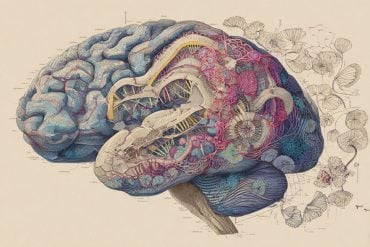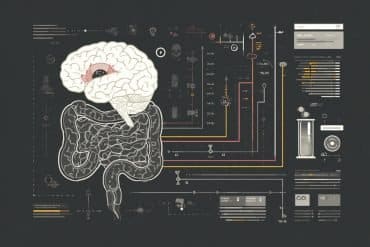Summary: A new computational model sheds light on the complexity of smell identification. Researchers report different brains know how to associate new similar odors, so long as they have experienced an overlap in odors over their lifetime.
Source: Zuckerman Institute.
In a new study, Columbia scientists have discovered why the brain’s olfactory system is so remarkably consistent between individuals, even though the wiring of brain cells in this region differs greatly from person to person. To make sense of this apparent paradox, the researchers developed a computational model showing that two brains need not have previously sniffed the same exact set of odors in order to agree on a new set of scents. Instead, any two brains will know to associate new similar odors with each other (such as two different flowers) so long as both brains have experienced even the smallest overlap in odors during their lifetimes.
This work was published last week in Neuron.
“Many of the brain cells, or neurons, in our olfactory system are wired together seemingly at random, meaning that the neurons that activate when I smell a rose are different than yours. So why do we both agree with certainty what we’re smelling?” said the paper’s senior author Larry Abbott, PhD, a computational neuroscientist and principal investigator at Columbia’s Mortimer B. Zuckerman Mind Brain Behavior Institute. “By creating this model, we could detect, for the first time, the patterns that underlie seemingly random activity, revealing a mathematical consistency to how our brains are identifying scents.”
The journey an odor takes from the nose to the brain is labyrinthine. When an odor enters the nasal cavity, specialized proteins called olfactory receptors send information about that scent to a designated location in the brain called the olfactory bulb. In a series of pioneering studies in the 1990s, Richard Axel, MD, a codirector at Columbia’s Zuckerman Institute and a co-author of the new Neuron paper, discovered the more than 1,000 genes that encode these olfactory receptors. This work, which was performed alongside his colleague Linda B. Buck, PhD, earned them both the 2004 Nobel Prize in Physiology or Medicine.
Today’s paper focuses on how information leaves the olfactory bulb and is interpreted by a brain region called the piriform cortex. The piriform cortex is believed to be a crucial structure for processing odors. Because no two whiffs of an odor are identical, the brain must make associations between odors that are similar. This process, called generalization, is what helps the brain to interpret similar smells.
“Generalization is critical because it lets you take the memory of a previous scent — such as coffee — and connect it to the odor of coffee you’re currently smelling, to guide you as you stumble to the kitchen in the morning,” said Evan Schaffer, PhD, a postdoctoral researcher in the Axel lab and the paper’s first author.
However, as scientists have investigated the concept of generalization, they have been puzzled by two paradoxes about the piriform cortex. First, the neural activity in the piriform cortex appeared random, with no apparent logic or organization, so researchers could not tie a particular pattern of neural activity to a class of scents.
And second, the piriform cortex itself seemed too big. “Scientists could deduce a need for only about 50,000 of the roughly one-million piriform cortex neurons in the human brain,” said Dr. Schaffer. “Given how energetically expensive neurons are, this raised the question: Why are there so many neurons in this part of the brain?”
The researchers developed a mathematical model that offered a resolution to both paradoxes: Two brains could indeed agree on a class of scents (i.e. fragrant flowers versus smelly garbage) if the neural activity came from a large enough pool of neurons.
The idea is similar to crowdsourcing, whereby different people each analyze one part of a complex question. That analysis is then pooled together into a central hub.
“This is analogous to what is happening in the piriform cortex,” said Dr. Schaffer. “The different patterns of neural activity generated by these one-million neurons, while incomplete on their own, when combined give a complete picture of what the brain is smelling.”
By then testing this model on data gathered from the brains of fruit flies, the team further showed that this neural activity helps two brains to agree on common odors, even with limited common experience.
Scientists have long argued that two brains must share a common reference point, such as each having previously smelled a rose, in order to identify the same scent. But this model suggests that the reference point can be anything — the memory of the scent of a rose can help two people agree on the smell of coffee.

“Even the tiniest bit of common experience seems to realign the brains, so that while my neural activity is different than yours, the association we each make between two related scents — such as flowers — is similar for both of us,” said Dr. Schaffer.
This model, while lending insight into a long-held paradox of perception, highlights an underlying elegance to the olfactory system: despite containing different neurons, memories and experiences — two brains can still come to an agreement.
“You and I don’t need to have sniffed every type of odor in the world to come to an agreement about what we’re smelling,” said Dr. Schaffer. “As long we have a little bit of common experience, that’s enough.”
Funding: This research was supported by the Gatsby Charitable Foundation, the National Science Foundation NeuroNex Award (DBI-1707398), the Simons Collaboration on the Global Brain and the Howard Hughes Medical Institute.
The authors report no financial or other conflicts of interest.
Source: Anne Holden – Zuckerman Institute
Publisher: Organized by NeuroscienceNews.com.
Image Source: NeuroscienceNews.com image is in the public domain.
Original Research: Abstract for “Odor Perception on the Two Sides of the Brain: Consistency Despite Randomness” by Evan S. Schaffer, Dan D. Stettler, Daniel Kato, Gloria B. Choi, Richard Axel, and L.F. Abbott in Neuron. Published April 26 2018.
doi:10.1016/j.neuron.2018.04.004
[cbtabs][cbtab title=”MLA”]Zuckerman Institute “A Rose is a Rose is a Rose: Mathematical Model Explains How Different Brains Agree on Smells.” NeuroscienceNews. NeuroscienceNews, 1 May 2018.
<https://neurosciencenews.com/math-olfaction-8931/>.[/cbtab][cbtab title=”APA”]Zuckerman Institute (2018, May 1). A Rose is a Rose is a Rose: Mathematical Model Explains How Different Brains Agree on Smells. NeuroscienceNews. Retrieved May 1, 2018 from https://neurosciencenews.com/math-olfaction-8931/[/cbtab][cbtab title=”Chicago”]Zuckerman Institute “A Rose is a Rose is a Rose: Mathematical Model Explains How Different Brains Agree on Smells.” https://neurosciencenews.com/math-olfaction-8931/ (accessed May 1, 2018).[/cbtab][/cbtabs]
Abstract
Odor Perception on the Two Sides of the Brain: Consistency Despite Randomness
Highlights
•A random model predicts observed preservation of correlations in piriform responses
•The model supports consistent agreement about odor quality among individuals
•Consistent generalization may require the full complement of piriform neurons
Summary
Neurons in piriform cortex receive input from a random collection of glomeruli, resulting in odor representations that lack the stereotypic organization of the olfactory bulb. We have performed in vivo optical imaging and mathematical modeling to demonstrate that correlations are retained in the transformation from bulb to piriform cortex, a feature essential for generalization across odors. Random connectivity also implies that the piriform representation of a given odor will differ among different individuals and across brain hemispheres in a single individual. We show that these different representations can nevertheless support consistent agreement about odor quality across a range of odors. Our model also demonstrates that, whereas odor discrimination and categorization require far fewer neurons than reside in piriform cortex, consistent generalization may require the full complement of piriform neurons.






